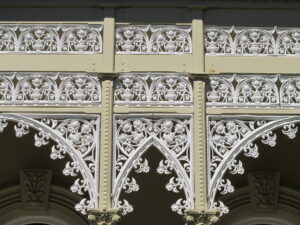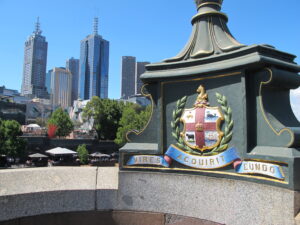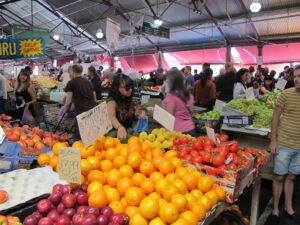We had just about finished the booking of a flight to Brisbane, and Qantas was selling us options: better seating, a car to rent, hot lunch, more baggage, and a carbon offset for our trip.
Now we try to be as green as we can be, but we’re pretty hardened after putting up with all the ways the airlines try to extract money from us above the base pricing of a ticket. Our favorite is Spirit Airlines, which charged us extra for a seat, not just a deluxe economy seat, but any seat. Apparently the airfare only entitled us to hang onto the wing or something.
The offset is a lot easier sell to us. We have paid for it before, both for flights and for hostel stays. Qantas’ calculation of the cost, our retribution for adding CO2 due to our flight, wasn’t even a lot of money, not as much as we might have guessed for four and a half hours of flying. So once again we added the offset, this time $5.56, to our airfare. Here’s why you should consider doing the same.
According to Qantas calculations, we each would release 137 kg of CO2 in the two hour outgoing flight and 163 kg going against prevailing winds on the return. The cost per kilo? Less than a penny. Under a cent for over 2 pounds of greenhouse gas released.
That cost is about right according to Wikipedia’s article on “Carbon Tax” (and pricing). Qantas states that over 95% of the emissions come from jet fuel use. Each liter of jet fuel spews out 2.65 kilos of carbon dioxide, so the plane has to use about 50 liters (say, 12 to 13 gallons) in the tank for each of us, with a calculated cost of about $1.60 (against the $1.27 we paid). Maybe Qantas has more efficient planes on average, but we got a good deal!
Surprisingly, driving is only slightly worse with two people in the car. With a pretty fuel efficient car, we would use 65-70 liters each to get to Brisbane and release about 160 kg of CO2 each (vs. 137). For that privilege, we should be paying $8 or 9 in total for carbon offsets. Of course, there is no ready mechanism to do that. Carbon toll both?
The big question though is what happens to the $5.56 we sent to Qantas?
The aim, of course, is to “neutralize” the CO2 we helped put into the air. So the money Qantas collects helps fund specific projects that correspondingly reduce levels of this greenhouse gas, the one most responsible for global climate warming. These projects are vetted by various organizations including the Aussie government and further audited by “independent verifiers” approved by the government.
Qantas cites five such projects benefiting its Asian neighbors.
Siam Cement Biomass Project (Fuel switching): According to Qantas, this “replaces fossil fuels with renewable biomass in five cement manufacturing plants in Thailand. Previously, cement manufacturers burned fossil fuels like coal, lignite (brown coal), pet-coke and heavy fuel oil in kilns to manufacture cement. Now, the introduction of renewable biomass to help replace fossil-fuels has reduced carbon emissions.” The project comes with nice side benefits as well: reducing local air pollution, preventing environmental damage from fossil fuel extraction, fostering local farmers in producing biomass plus encouraging investment with more local jobs.
Efficient Cook Stoves in Cambodia: “The ‘New Lao Stove’ is a cook stove that is being introduced in Cambodia. The stove releases fewer carbon emissions than traditional cook stoves by burning fuel wood more efficiently.” Usage of wood is reduced by about one-fifth. Over one million stoves have been distributed so far, also freeing around $9 million of cost for Cambodians over 8 years and reducing deforestation.
Hydropower – The Coc Dam in Lao Cai province, Vietnam: The relatively small dam “introduces a lower carbon electricity source to the national grid. This helps reduce carbon emissions associated with fossil fuel based power that exists in the region. Small hydropower projects help avoid the negative environmental impacts of larger dams.”
Wind Power – Hebei Kangbao Sanxiatian Wind Farms in China: Harnessing wind energy reduces “the use of fossil fuel-derived electricity in the North China Power Grid. Wind farms reduce carbon emissions by replacing fossil-fuel-based power with wind energy.”
And right at home in Australia…Native Forest Protection Project: Tasmania: This project compensates private landowners for preserving native forest in the Central Highlands of Tasmania, instead of logging it. “The land in the project area is degraded native forest which has been logged in the past and – in the absence of carbon revenue – would continue to be either selectively logged or cleared for agriculture in the future.” A nice side benefit for us is ensuring viable habitat for endangered species like the wedge-tailed eagle and Tasmanian Devil (see our post).
You don’t have to be a muesli-crunching greenie to see the benefits of these projects, putting aside the complexities of determining your carbon footprint, or rather wing-print in the air. Even if you don’t credit the science on global warming, you might still want to offset worse air quality. Certainly, after reading this list of admirable projects, we were ready to double down on our carbon offsets, though Qantas makes no provision for putting more money in the program.
If you travel by air, you too will likely be offered a carbon offset soon. The airline association IATA reports that 32 member airlines have some such program as of last year. In Australia, all the majors seem to have one. And other industries, at least in Australia with national encouragement, have started programs as well. We recently received an electric bill in an envelope “made from National Carbon Offset Standard certified postspeed Carbon Neutral paper.”
So, the next time you fly, whether you opt for the seat with extra leg-room or not, do buy a carbon offset. You’ll breathe easier.
________________________
If you want to read more about this program, go to www.qantas.com.au/travel/airlines/fly-carbon-neutral/global/en.You’ll also find this cute video there:







WOW- you guys get some great information-and I love reading about it! This is good stuff! Thanks for helping us to be more aware!!